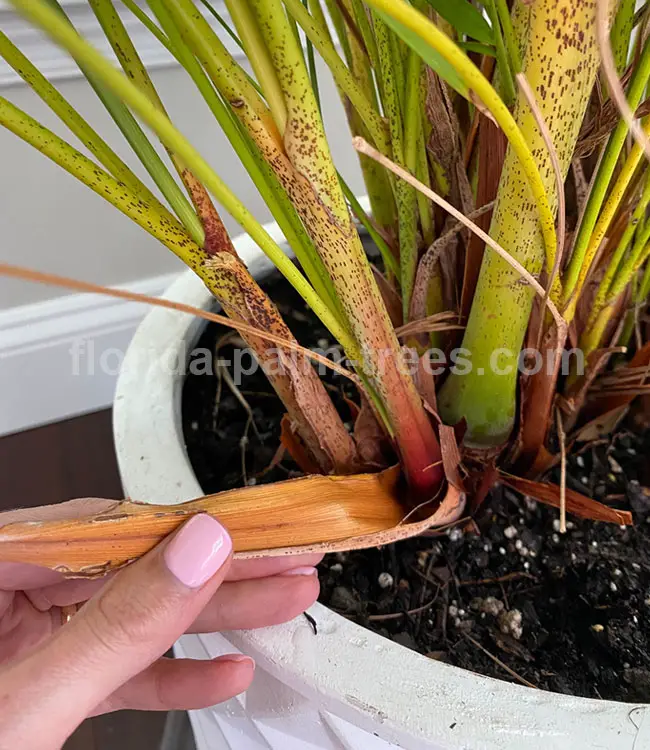
Are you the type of person who can’t keep a plant alive if your life depended on it? Well, fear not, because I’ve got the ultimate guide to help you turn your indoor palm trees into flourishing, green masterpieces. So, put down that watering can, and let’s dive into the world of indoor palm tree care.
Picture this: You’re lounging in your living room, surrounded by lush, green palm trees, sipping a coconut drink, and pretending you’re on a tropical island.
Sounds like paradise, right? Indoor palm trees have a magical way of bringing a slice of vacation into your home. They’re like a one-way ticket to “staycation” mode.
But wait, there’s more! These leafy companions don’t just look good; they’re also nature’s air purifiers.
They’re like the superhero janitors of the plant world, sweeping away toxins and pumping out fresh, oxygen-rich air. Who knew your home could be this healthy and stylish?
What’s even better, indoor palm trees are loved and enjoyed by everyone. No matter the size of your space, there’s a palm species that can thrive in your indoor environment.
All you gotta do is pick your palm pal, learn their quirks, and make sure you don’t accidentally turn them into a houseplant horror story.
Each palm type has its own preferences, but there are some universal tips that’ll keep your leafy friend thriving.
Think of it as the plant version of pampering – the perfect potting mix, just-right watering, a spotlight-worthy light source, a stylish container, keeping the humidity on point, and a fertilization routine that even your green-thumbed grandma would envy.
Nail these basics, and your palm will be living its best life!
Choosing the Right Palm Tree as a Houseplant
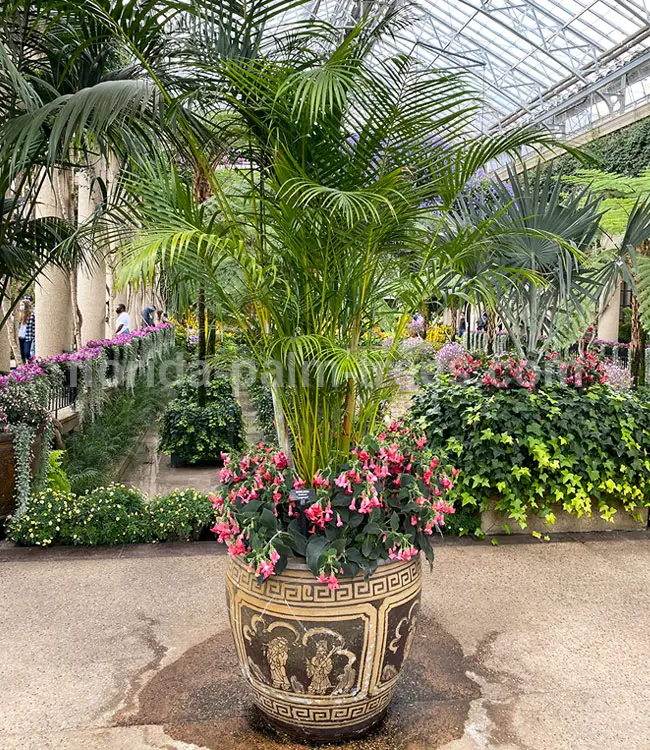
The first rule of Palm Club: Choose the right palm for your home sweet home.
Whether you’re browsing online or exploring your local nursery, when you spot that charming little green beauty that catches your eye (also known as #thebestplantever), take a moment to do a bit of research before welcoming it into your home.
Now, I know it might look all tiny and adorable right now, but here’s the million-dollar question: how big is this green buddy going to get, and at what speed?
Just like you wouldn’t try to fit a giraffe into your studio apartment (I mean, where would you even find a pet giraffe?), not all palm trees are suited for indoor living.
Does it thrive in bright light or can it handle low light conditions? What about low humidity?
Understanding these key details will help you figure out if this palm is your indoor plant soulmate.
It’s important to note that not all palm trees are cut out for indoor life. Indoor conditions are like the “comfy pants and Netflix” version of the great outdoors – less humidity, softer light, and a bit less air circulation.
Sure, you could invest in a humidifier, maintain a warm temperature, and strategically place fans around your house to mimic outdoor conditions, but that’s a lot of effort. Are you really up for living in a mini greenhouse?
So, here’s a tip: Don’t try to be a hero! Stick with palm varieties that are known to thrive indoors and can handle a bit of neglect.
Top 10 Most Popular Indoor Palm Trees
Many palm species have proven their adaptability to indoor living. To thrive as a houseplant, a palm must be able to endure low light levels and dry air. Here’s a list of the most popular indoor palm trees:
- Areca Palm (Chrysalidocarpus lutescens)
- Bamboo Palm (Chamaedorea seifrizii)
- Chinese Fan Palm – (Livistona chinensis)
- Kentia Palm – Howea forsteriana
- King Palm – Archontophoenix alexandrae
- Majesty Palm – Ravenea rivularis
- Lady Palm – Rhapis excelsa
- Parlor Palm – Chamaedorea elegans
- Ponytail Palm – Beaucarnea recurvata
- Pygmy Date Palm – Phoenix roebelenii
These palm varieties are known for their ability to thrive in the indoor conditions found in most homes, making them excellent choices for your indoor plant collection.
Light Requirements For Indoor Palms
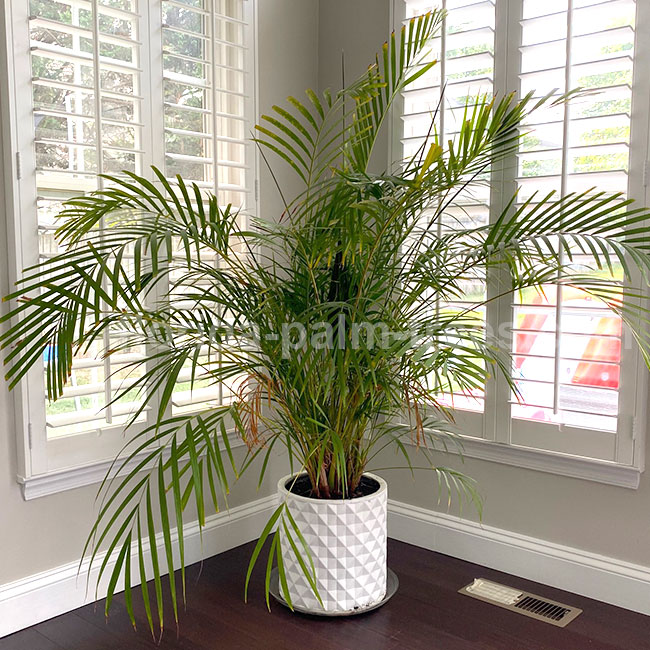
Palms are like the sun-seeking sunflowers of the plant world – they need light to survive, and natural light is their best friend.
While some palm species prefer bright light, others can handle lower light conditions. However, let’s be clear right from the start: no palm will survive in a dark closet!
In general, most palms will thrive in a bright room near a window where they can bask in plenty of indirect sunlight. This setup usually keeps them happy and healthy.
Now, there are some palm species that are sun lovers. They’ll happily soak up the sun’s rays for most of the day.
If you have a south-facing window, it’s the perfect spot for these sun-seeking palms, as it provides bright, direct sunlight for the majority of the day.
But here’s a pro tip: Be mindful that sunlight passing through window panes can become supercharged and cause issues like leaf yellowing or even sunburn on your palms.
If you notice whitish-yellow marks on your plant, it’s a sign that it might need to move to a spot with less intense sunlight.
In most cases, even palms that enjoy full sun when they’re mature will do better in their younger years with bright, indirect light.
Now, here’s a tricky situation to avoid: Don’t place your potted palm right next to an air vent. During the cold winter months, the dry, hot air blowing from the vent can lead to your palm’s leaves drying out and turning yellow.
I know, it’s a bit of a challenge because many air vents are conveniently located above or below windows. What’s up with that?
During the warmer months, if you want to give your palm a little outdoor adventure, go for it! However, be cautious about exposing it to direct sunlight right away.
Outdoor light levels are like the VIP section, so initially, set your plant up in a shady spot to prevent any sunburn.
You can gradually move it to a location with more light as it gets accustomed to the higher levels. This way, your palm can enjoy the great outdoors without any sun-related mishaps.
Use Of Artificial Light For Indoor Palms
If your home or office lacks a window with abundant natural light or a cheerful skylight, you can still have thriving indoor palms with a little help from supplemental lighting.
It’s a surprising fact that many plants, including palms, can flourish in office settings under the gentle glow of fluorescent lights, even without a view to the outside world.
The same magic can be done at home. All you need are a few grow lights to keep your palms happy!
Unlike their incandescent counterparts, fluorescent and LED lights emit a spectrum of light that plants crave. Plus, they won’t break the bank when it comes to purchasing and running them.
Regardless of which lighting system you opt for, make sure to provide a minimum of 8 to 10 hours of supplemental light every day.
This ensures that your indoor palms get the light they need to thrive and remain a vibrant part of your indoor green oasis.
Why Air Circulation Matters
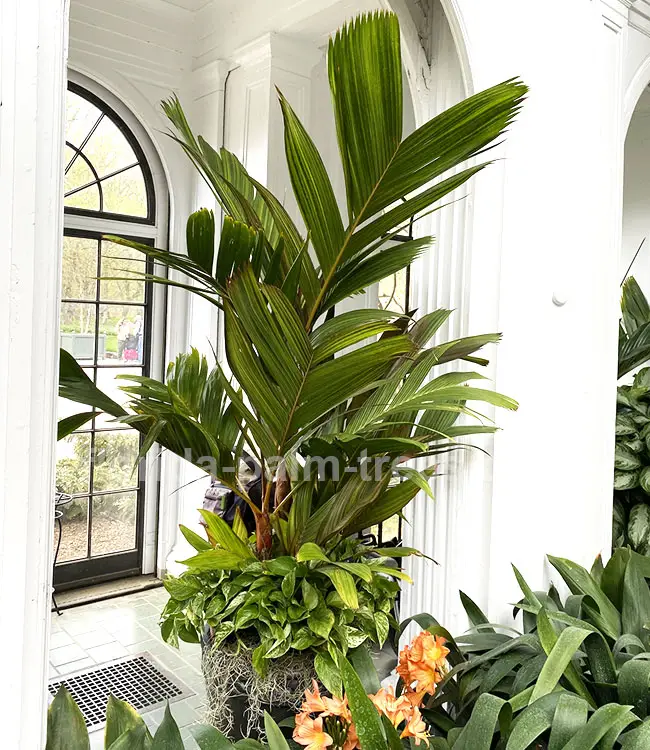
Air circulation plays a vital role in keeping your indoor plants healthy. It helps in keeping those pesky insects at bay and ensures your plants thrive.
While replicating the natural outdoor airflow indoors is a bit challenging, there are simple ways to create a beneficial air movement for your plants.
One effective method is placing your plant beneath a ceiling fan or close to a small circulating fan. During the warmer months, opening windows can also aid in maintaining good air circulation.
However, it’s important to avoid exposing your plant to cold drafts from doors, windows, or air conditioning units in colder weather.
How To Increase Indoor Humidity
In the winter months, when your heater is cranking, indoor humidity levels tend to drop significantly. Since most palm plants originate from humid regions, providing extra moisture is crucial for their well-being.
You can achieve this by placing the plant container on a platter filled with damp gravel. This simple trick increases the moisture level around the plant without causing harm to its roots.
Alternatively, regularly misting your plant with water throughout the day or using a room humidifier can also be quite helpful.
For a temporary solution, consider relocating your palm plant to a bathroom with a bright window. Steamy showers in the bathroom add moisture to the air, creating a more humid environment for your plant to thrive.
During the warmer months, don’t hesitate to move your palm plant outdoors. It can benefit from the naturally higher humidity levels and enjoy a rejuvenating experience in the fresh air.
What’s the Best Soil pH for Palms?
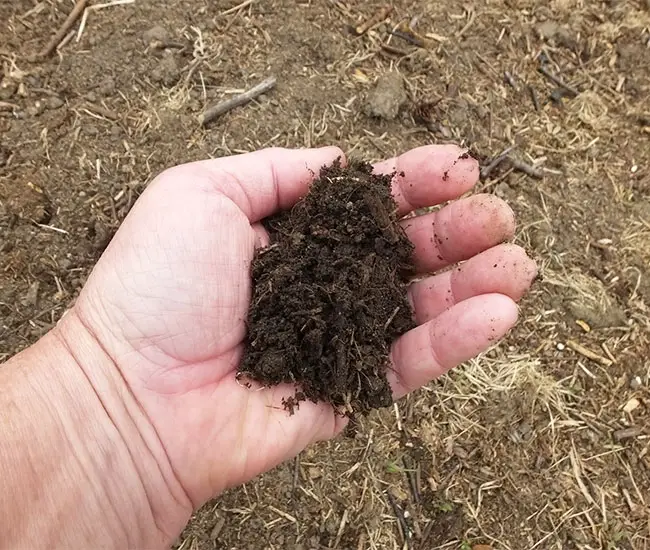
Palms are adaptable when it comes to soil acidity, thriving in a broad pH range. They prefer loose, well-draining, and light soil. But if you’re aiming for the sweet spot, a pH level of 6.3 to 6.8 seems to work best for most types of palms.
Now, to find out where your soil stands on the pH scale, you can go fancy with a soil pH meter, or keep it budget-friendly with some soil acidity test strips. And the good news is, you can adjust the pH levels to suit your specific palm species.
If you want to make your soil less acidic, toss in some sulfur. On the flip side, if you’re looking to boost the pH, dolomite limestone is your go-to buddy. The more organic amendments you mix in, the more acidic your soil becomes.
Now, I get it. It might be tempting to scoop up some random old garden soil for your indoor palm. But hold up! That soil might not be palm-friendly. It could have all sorts of critters or pathogens you don’t want indoors. So, stick to a well-balanced mix.
While there’s no one-size-fits-all soil recipe (it depends on what’s available in your neck of the woods), I’ll give you some handy guidelines to help you get that soil mix just right.
My Ideal Soil Mix Recipe for Container Palms
Creating the perfect soil mix for potted palms is like whipping up a secret recipe for plant happiness. You’ll want a blend that holds water just right, supports those roots, and lets excess moisture escape. It’s all about keeping your palms happy!
After years of tinkering with different soils for my potted palms, I’ve got a formula that’s a winner for almost any palm type.
Here’s the breakdown:
- 30% Perlite: This stuff is like nature’s sponge. It’s a volcanic glass that’s great at holding onto water and letting your plant’s roots breathe.
- 30% Peat Moss: Think of it as a cozy, moisture-hugging blanket for your soil. Peat moss holds onto nutrients and releases moisture to your plant when it needs it.
- 10% Topsoil: Don’t grab dirt from your garden! Get a high-quality topsoil from the store. It’s been treated to keep out pesky weeds and critters.
- 10% Coarse Sand: Sand gives your mix a boost in the drainage department.
- 10% Redwood Shavings: These shavings are like the backbone of your soil. They improve structure, drainage, and nutrient retention. Plus, they break down slowly, so your mix stays reliable.
- 10% Pumice: It’s like the rock star of your soil mix. Pumice forms when lava meets water and does wonders for moisture retention and aeration. If it’s hard to find or pricey, go for perlite instead.
Other Potting Soil Mixes
Now, I’ve seen some folks swear by a simple 50% peat moss and 50% perlite mix. It’s a budget-friendly choice and works for seedlings.
But in the long run, it might not give your palms the VIP treatment they deserve. That’s why I suggest adding a pinch of topsoil and sand to the mix. Here’s what you can use:
- 40% Peat Moss
- 40% Perlite
- 10% Coarse Sand
- 10% High-Quality Topsoil
Looking for a Pre-Made Mix?
If you’re short on time or just want a ready-to-use option, consider a well-draining potting mix with minimal organic matter. Something like Miracle-Gro Cactus, Palm & Citrus Potting Mix should do the trick.
This mix is made with an organic foundation of peat moss and forest materials, along with a blend of sand and perlite.
It’s designed to provide excellent drainage while also enriching your plants with essential nutrients like Potassium, Nitrogen, and Phosphorous, supporting their growth without the worry of root damage.
It’s a great choice for gardeners who have a smaller number of plants and want to save time. This mix not only ensures rapid drainage but also maintains a lightweight, airy texture, making it a convenient option for your gardening needs.
How to Improve Drainage for Your Container Palms
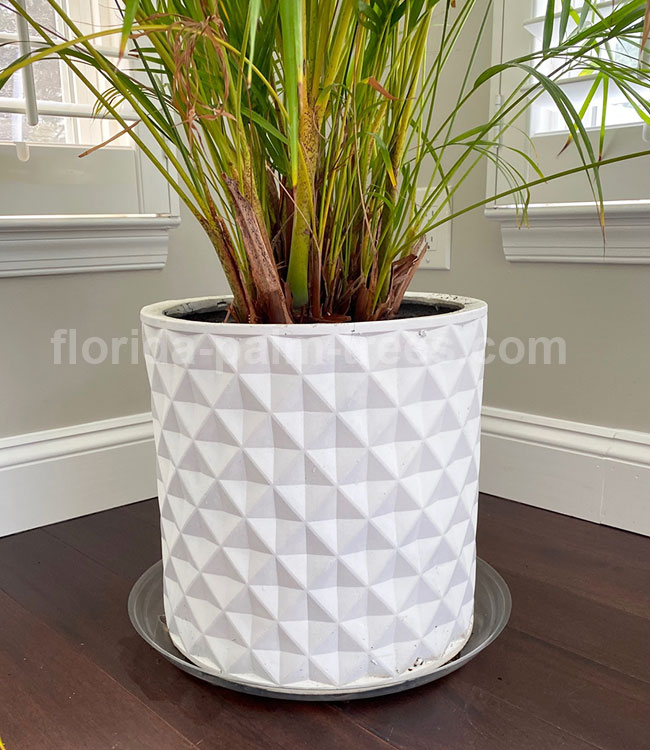
When it comes to repotting your palms, here’s the golden rule: NEVER plant them in a container without a drainage hole. All plants crave good drainage, and they won’t survive without it!
Now, some pots come equipped with drainage holes, often accompanied by a built-in or attached drip pan at the base. Others might even throw in a classy ceramic saucer to match.
But if your adorable container that you can’t live without doesn’t come with one, fear not! You’ve got options.
Option one: You can use a slightly smaller container that does have drainage holes (even if it’s not the prettiest) and place it snugly inside your lovely new pot. Toss in a few rocks at the bottom of the inner pot to create a space for excess water to escape.
Option two: Take matters into your own hands by adding a drainage hole to your pot. That’s exactly what I did! Honestly, it’s tough to find a good-looking pot that comes with a matching saucer.
After scouring popular stores like Lowe’s, Home Depot, and Ikea with no luck, I decided to go for some sleek, modern pots. My husband stepped in and drilled holes in them for me. Then, I ordered a bunch of clear plastic saucers from Amazon to match the pot sizes.
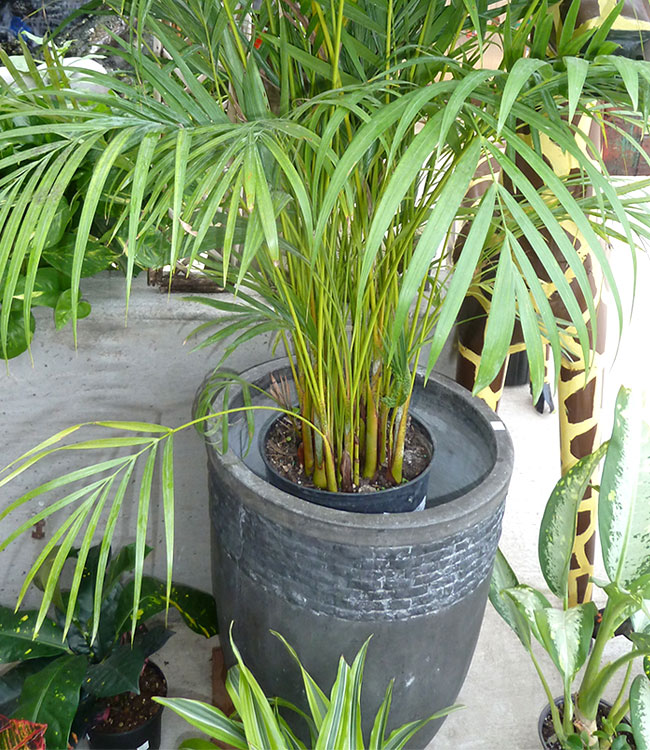
Now, I was a tad worried that the plastic saucers might look a bit tacky and cheap. But guess what? They turned out to be just perfect!
Because they’re clear, they practically disappear under the pot, hardly noticeable at all. So, problem solved! Your palms get the drainage they need, and your pots stay stylish.
How to Water Your Indoor Palms
Believe it or not, the top cause of indoor palm casualties is not underwatering, but rather the opposite—OVERWATERING! This is especially true if your pot lacks drainage holes.
When it comes to watering your indoor palms, remember that more doesn’t always mean better. The key is to strike a balance, ensuring that the soil stays suitably moist without drowning your plant.
Your home’s unique conditions, including light, humidity, and temperature, all influence how quickly the soil in your palm’s pot dries out. Unlike the great outdoors, indoor soil tends to hold onto moisture longer.
While your exact watering schedule might differ from mine, I strongly recommend establishing a consistent routine. Your palm pals will thank you, and having a schedule will make it easier to remember when to water (or not!).
For instance, I make it a habit to water all my indoor houseplants every Saturday morning while I’m doing my weekly cleaning. It’s a convenient time for me to give their fronds a little misting while I’m at it.
Sometimes, you might notice the soil at the top pulling away from the sides of the pot or forming a crust. When you water, it can seem like the water just runs down the inside of the pot and out the bottom without soaking the roots.
The fix is simple: gently break up the soil and make a few holes in it using a pencil or a chopstick. This creates tiny pockets for the water to spread evenly, improving absorption and giving your palm’s roots some much-needed air. Your indoor palms will appreciate the extra care!
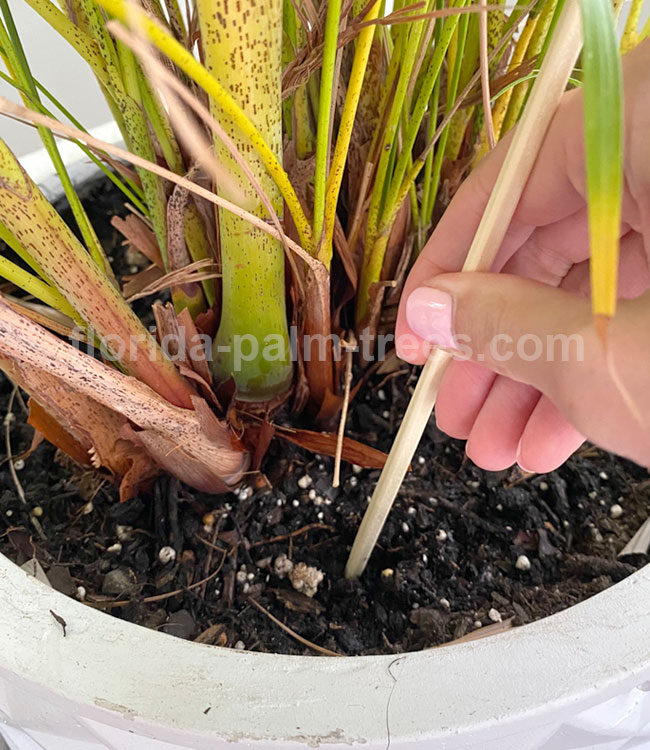
How Much Should I Water My Potted Palms
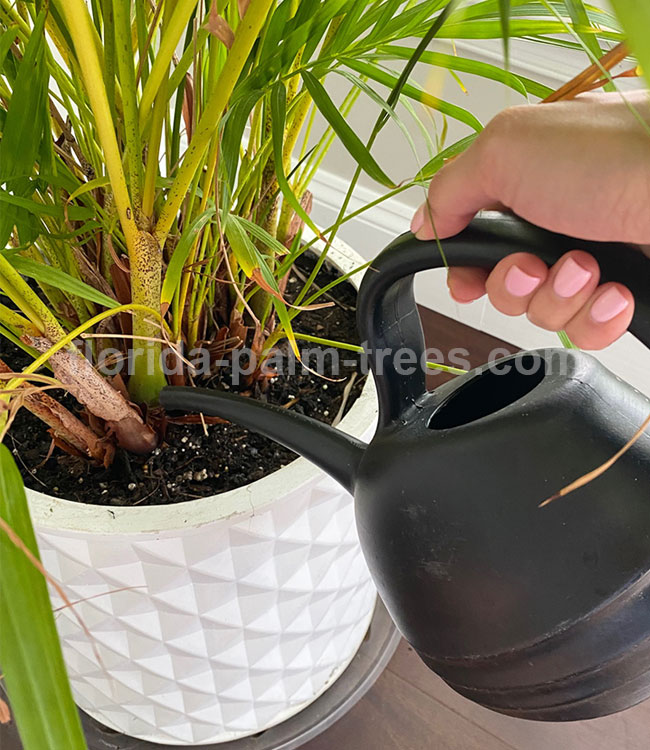
Here’s the scoop on watering your potted palms: You should break out the watering can when the soil starts feeling nearly dry to the touch. Take your index finger and poke it about an inch into the soil. If it feels damp and cool, hold off a bit until it dries out some more.
When it’s time to water, do it slowly and evenly, making sure the entire root zone gets a good soaking. Keep going until you see water trickling out of the drainage holes and pooling in the saucer below.
Now, let’s talk numbers. The general rule of thumb is to use about 5% of your container’s volume in water. So, if you’ve got a 10-gallon plant, you’ll want to use roughly half a gallon of water.
But here’s the thing: it’s not a strict formula. Use a bit of common sense. The actual amount you need depends on factors like the type of soil, the plant’s specific needs, the size of the container, and more. Some of my palms get a few cups of water each time.
When you’re uncertain, it’s better to err on the side of caution and water a bit less. Most indoor palms are pretty chill when it comes to drought, so they’ll be just fine.
Now, here’s the kicker: I’ve seen some websites suggest using 10 gallons of water for a 10-gallon palm! Seriously, that’s a recipe for drowning your plant. Stick with the 5% guideline, and you’ll keep your palms happy without turning your home into a swamp!
Signs of Overwatering in Palm Trees
When it comes to overwatering, it’s not a palm tree’s best friend. It can lead to some pretty nasty issues like root rot and other diseases. So, how do you know if you’re giving your palm a bit too much love in the water department? Here are some telltale signs to watch out for:
- Wilted Canopy with Soft, Limp Leaves: Your palm’s once proud crown of leaves starts to look sad, with leaves going all soft and floppy.
- Leaves Turning Brown with Yellow Circles: If you notice brown patches on those green fronds, often with yellow rings around them, that’s a red flag.
- Droopy Leaves That Turn Brown and Drop Prematurely: The leaves can become droopy and then go brown and fall off before they get a chance to dry out.
- Younger Foliage and New Growth Turning Brown: Even the fresh, green sprouts at the top can start turning brown and looking unhealthy.
- Foul Smell from the Root Zone: If there’s an unpleasant odor wafting up from the soil around your palm, that’s a bad sign.
- White Fungus-Like Growth on the Soil: You might spot something that looks like white fungus or fuzzy stuff growing on the soil surface.
- Soggy, Clumping-Together Soil: When you touch the soil, it feels overly wet and clumps together rather than being loose.
To rescue an overwatered palm, here’s the plan: Remove the soggy, infected soil, disinfect the pot, and give your palm a fresh start with a new potting mix.
A spritz of copper fungicide spray can also help in case any sneaky fungi decide to join the party. Your palm will thank you for the intervention!
How to Prevent Salt Buildup in Your Soil
Salt buildup can be a major headache for potted palm owners. Many of us use tap water, which carries dissolved salts, and when the water evaporates from the soil, it leaves those salts behind.
Just like the mineral deposits that form inside your teapot, these salts (like sodium, calcium, magnesium, and more) accumulate in the soil and can spell trouble for your palm.
You can keep tabs on salt levels using a simple, inexpensive soil meter or soil pH strips. Ideally, your palm’s soil should have a pH level between 6.3 to 6.8.
So, how do you spot salt buildup? Look out for brown edges on the fronds and leaf tips. In more serious cases, the lower leaves might start browning until only a few sad-looking leaves remain. Left unchecked, this can lead to your palm’s decline and, ultimately, its demise.
But fear not, there’s a solution! To flush out those unwanted salts, give your palm a good soak with plenty of rainwater or distilled water. On a warm day, you can even take it outdoors and water it 10-15 times. If it’s chilly outside, no worries, just do it in the bathroom shower.
This flushing process should help remove all the accumulated salt. After your plant has had its water therapy, bring it back indoors. You might need to do this leaching process a couple of times a year, depending on how severe the salt buildup is.
To slow down the salt buildup, consider watering your houseplant with distilled or rainwater. However, keep in mind that fertilizers can also contribute to salt buildup, so it’s a good idea to perform a leaching treatment at least once a year to keep your palm thriving.
How and When to Feed Your Indoor Palms
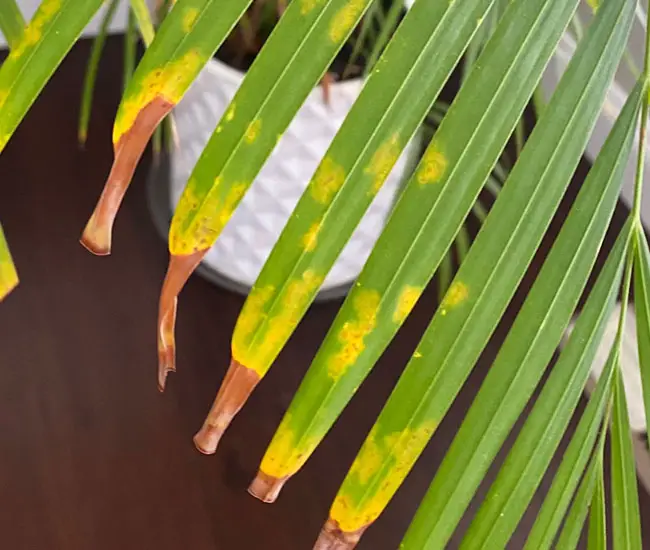
Looking after potted palms is not the same as caring for those planted outdoors. Since indoor palms don’t have to brave the cold, they’re hungry for nutrients all year round.
Now, when you stroll down the fertilizer aisle, you’ll come across numbers like 12-4-12, 15-5-15, or 3-1-2 on the packaging. Those are the NPK numbers, representing Nitrogen (N), Phosphate (P), and Potassium (K).
Here’s the secret: Go for a fertilizer with equal amounts of Nitrogen (N) and Potassium (K). But that’s not all! A top-notch fertilizer will also pack at least six other micronutrients, like Magnesium, Manganese, Sulphur, Boron, Copper, Iron, and Zinc.
Now, I’ll be honest, I’m not the best at keeping up with feeding my houseplants. Life gets busy, right? So, I opt for continuous-feed fertilizer, like the ones from Jobe’s.
Just stick those spikes in the soil, and you’re good to go! No measuring, no mess, no funky odors. They may cost a bit more, but they’re a real time-saver.
If you’ve got a jungle of potted palms, liquid or soluble fertilizers are budget-friendly but require a tad more time. These are powders you mix with water and then apply to your palms.
Don’t forget about the organic options, too! Think blood meal, bone meal, manure, fish emulsion, and worm castings. They work more slowly but pose less risk of overfeeding and burning your palms.
Top 7 Tips for Fertilizing Your Container Palms
When it comes to feeding your container palms, here are some handy tips to keep in mind:
- Always follow the directions on the fertilizer package and err on the side of using less. It’s safer to give your palm a bit less food than to overfeed it. Remember, too little fertilizer might slow down growth, but too much can harm or even kill your plant!
- Never fertilize dry soil. Doing so can lead to plant burn and, in some cases, plant death. Always water your palm first before applying fertilizer.
- It’s a smart move to fertilize your palm after you’ve leached it (the process of washing the salts from the surface of the soil by watering it) to remove any salt buildup. Don’t fertilize right before leaching.
- Be careful not to get fertilizer on the crown of the plant, as it can harm the leaves.
- If you’re using granular fertilizer, don’t dump it all in one spot at the base. Instead, spread it evenly around the root area.
- Keep the fertilizer away from the trunk of the palm to avoid damaging it.
- If you notice issues with palm growth, consider testing your soil for salt levels using inexpensive soil strips.
How and When to Repot Palm Trees
Palms growing in containers will eventually need a change of scenery, so to speak. Over time, the potting mix breaks down, and the palm’s roots start feeling cramped, which can limit its growth. If you neglect repotting, your palm’s health may decline.
Slow-growing and smaller palm species can hang out in the same pot for two to four years. After that, it’s time to move them up to a larger container.
If you notice your palm has been stagnant in growth or its roots are poking through the drainage hole at the bottom, it’s a clear sign it needs a bigger pot.
Another indicator is when water quickly flows through the soil and out the bottom of the pot. This may suggest poor soil structure or root binding, signaling that it’s time for a new, roomier home for your palm.
Palm Tree Repotting Tips
When it’s time to repot your palm tree, here are some handy tips to make the process smoother:
- When you’re removing the plant from the pot, lay the pot on its side. Gently ease the root ball out without tugging on the stems. Start by loosening the soil along the inner walls of the container to reduce the risk of damaging the roots.
- Try to minimize disturbance to the roots. Unlike broadleaf plants, palms aren’t fans of root trimming. Many palm species lose all their roots during repotting and have to regrow them entirely.
- Keep as much of the old soil on the roots as possible. This helps reduce transplant shock—the stress your palm experiences during the move.
- Even if you plan to use the same pot, add some fresh soil to rejuvenate the growing environment.
- If you’re reusing a pot that previously housed another houseplant, give it a good wash with soapy water and perhaps a dash of hydrogen peroxide. This helps prevent the spread of pests and diseases.
- Place a layer of rocks at the bottom of the pot to enhance drainage.
- Put a small piece of breathable weed fabric at the bottom to stop soil from escaping through the hole.
- Plant the palm at the same depth it was growing before. Avoid burying the stalk with new soil or leaving the root ball exposed too high.
- Ensure you fill all the empty space around the sides of the plant when adding fresh soil. Avoid packing the soil tightly since palms prefer loose soil that absorbs and drains water effectively.
- After planting the palm, give it a thorough watering. Observe how the plant settles and check if you’ve got the depth right.
- Hold off on fertilizing for a few weeks to reduce transplant shock and give your palm time to adjust to its new home.
Pruning Your Container Palms
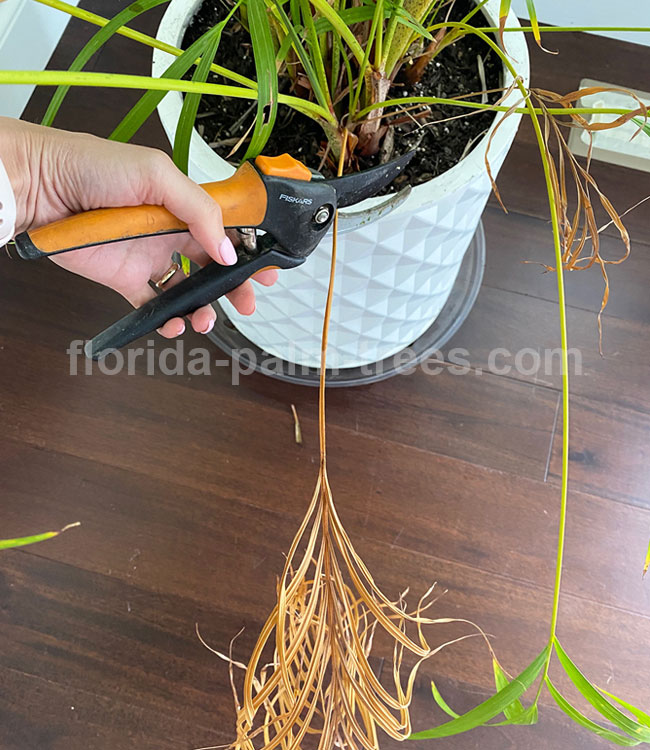
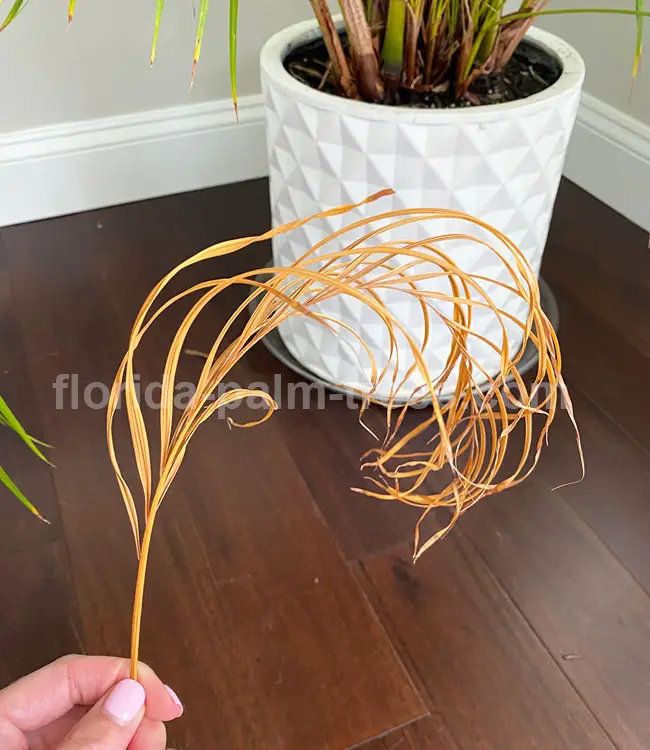
When it comes to pruning container palms, it’s usually a straightforward task. You won’t need to do much, but a little maintenance can go a long way in keeping your palms looking their best.
Most of the time, all you need to do is remove the dry, brown leaves to keep your plants tidy. These are typically the older leaves at the bottom that have naturally withered and need a trim.
For this job, you can simply use handheld pruners. If you notice that the tips of the leaflets have turned brown, you can trim those too.
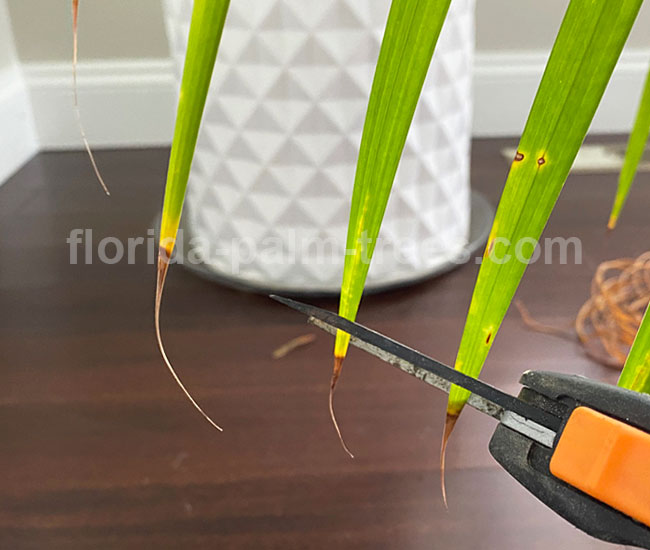
However, it’s important not to get too carried away with pruning. Over-trimming can actually do more harm than good.
You see, as those old leaves turn brown and die, the palm wisely moves nutrients to its newer fronds. If you prematurely remove these aging leaves, you’ll be taking away the palm’s source of nourishment.
Another thing to keep in mind is that cutting off green fronds with green leaf bases can leave permanent scars on the trunk.
These scars might make your palm more susceptible to fungal or bacterial infections, so it’s best to avoid such cuts.
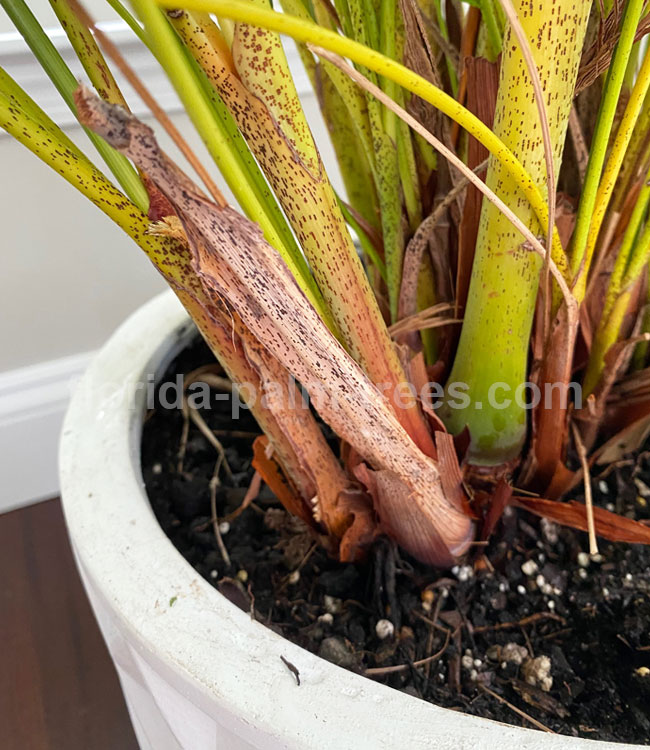
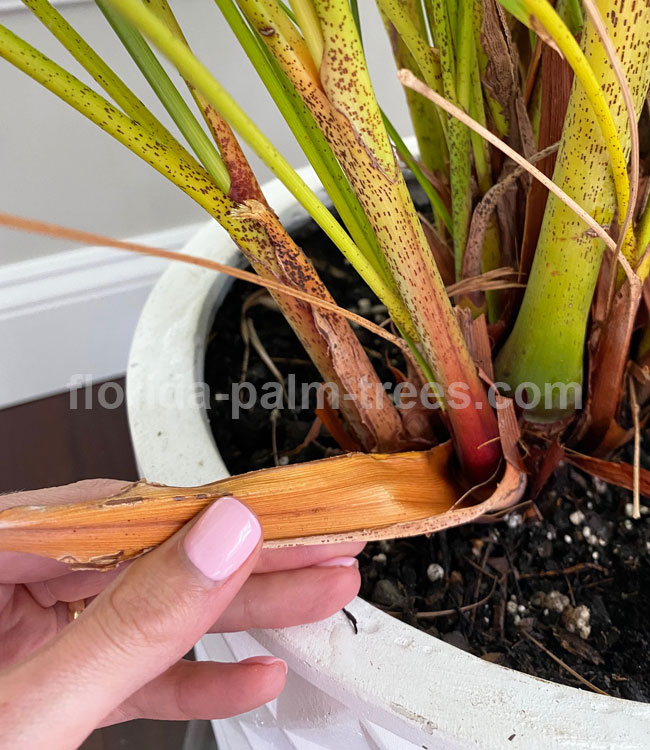
Lastly, don’t forget to clean your pruning tools with rubbing alcohol after use. This helps prevent the spread of various palm diseases. Since some palm stems can be quite prickly, it’s also a good idea to wear gardening gloves to protect your hands.
Common Indoor Palm Tree Problems
Indoor palm trees can encounter a range of issues, but most of them boil down to two main culprits: insufficient light and improper watering.
If you start noticing brown tips on the leaflets, and they’re getting progressively browner, the root of the problem likely lies beneath the surface.
These pesky brown tips often result from a few common factors: underwatering, overwatering, excessive fertilization, or low humidity.
Sometimes, it’s even a combination of these factors. The key to nursing your green companion back to health is pinpointing the precise cause.
Now, here’s a little trick: occasionally, the top layer of soil might appear dry while the bottom remains waterlogged.
This can suffocate the roots, leading to their demise. Conversely, if the soil doesn’t have enough moisture, the roots can dry out and wither.
When your palm’s leaves start looking washed out and pale, the issue might be a lack of sunlight. Consider relocating your palm to a brighter spot if possible.
If that’s not feasible, you can always provide some artificial light to give your palm the light it craves.
Indoor Palm Tree Pests
I won’t bore you with a comprehensive list of all the insect invaders that might target your cherished indoor plants. Fortunately, indoor plants are less prone to pest problems compared to their outdoor counterparts.
However, you might encounter the occasional fungus gnats (tiny, short-lived flies) or fruit flies if you’ve got stagnant water or excessively soggy soil in your pots. This is yet another reason to steer clear of overwatering your palm trees!
To deal with these pesky critters, you can opt for natural, non-toxic solutions. Whip up a hydrogen peroxide concoction by mixing one part of 3% hydrogen peroxide with four parts of water. Drench the soil with this mixture – it’s simple to make and harmless to your plants.
Apart from fungus gnats, the most common indoor palm tree pests are spider mites. These little troublemakers thrive in dry conditions with poor air circulation. If you spot yellow specks on your leaves, take a closer look for tiny moving dots or delicate webbing underneath the foliage.
Because spider mites are nearly microscopic, you’ll need a magnifying glass to spot them. To eliminate them, give the leaves a gentle wipe with a damp cloth or spray them with water. Insecticidal soap is also effective against spider mites.
To prevent a recurrence, boost the humidity around your plant and give it an occasional shower to wash away any lingering mites.
Mealybugs are another annoying pest to watch out for. These soft-bodied insects tend to hide on the undersides of leaves or in the crevices between leaves and branches. If you spot these little troublemakers, it’s time to take action!
Rub your plant with a mixture of soapy water and alcohol. Create a solution by mixing equal parts alcohol and water with a bit of dish soap, then give your palm a good wipe-down. This should slow them down. For complete mealybug eradication, use insecticidal soap.
Conclusion
And there you have it, folks—the basics of indoor palm tree care. You might have known some of this already, but I hope you’ve picked up a few new tips!
As you can see, caring for potted palms isn’t all that challenging. Most of the time, it’s about not smothering them with too much love and attention.
If, like me, you lead a busy life and can’t dedicate hours to pampering your plants, opt for palms that thrive indoors and can withstand a little neglect.
I often forget to leach my plants, so I ensure they all have drip trays and rocks at the bottom of their pots. This way, I don’t need to water them in the sink, bathtub, or shower.
I’m also not great at remembering to fertilize them on time, which is why I rely on slow-release formulas that feed them for months. And you know what? They’re thriving!

